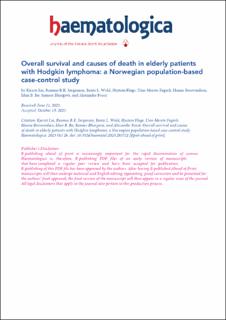| dc.contributor.author | Lia, Kjersti | |
| dc.contributor.author | R.K. Jørgensen, Rasmus | |
| dc.contributor.author | Wold, Bente Loftum | |
| dc.contributor.author | Fluge, Øystein | |
| dc.contributor.author | Fagerli, Unn Merete | |
| dc.contributor.author | Bersvendsen, Hanne Skjerven | |
| dc.contributor.author | Bø, Idun Bakke | |
| dc.contributor.author | Bhargava, Sameer | |
| dc.contributor.author | Fosså, Alexander | |
| dc.date.accessioned | 2024-04-11T12:29:43Z | |
| dc.date.available | 2024-04-11T12:29:43Z | |
| dc.date.created | 2023-12-08T16:15:13Z | |
| dc.date.issued | 2023 | |
| dc.identifier.issn | 0390-6078 | |
| dc.identifier.uri | https://hdl.handle.net/11250/3126118 | |
| dc.description.abstract | Elderly Hodgkin Lymphoma (HL) patients are poorly characterized and underrepresented in studies. In this national population-based study, we investigated cause-specific survival using competing-risk analysis in elderly HL patients compared to the normal population. Patients ≥ 60 years diagnosed between 2000-2015 were identified by Cancer Registry of Norway, records reviewed in detail and compared to data from Norwegian Cause of Death Registry for patients and cancer-free controls. Of 492 patients, 81 (17%) were ineligible for treatment directed specifically towards HL, mostly because of an underlying other lymphoma entity, whereas 74 (15%) and 337 (69%) were treated with palliative or curative intent, respectively. Median overall survival in patients ineligible for assessment of HLdirected therapies was 0.5 years (95% confidence interval [CI] 0.4-0.6), and for palliatively and curatively treated patients 0.8 (0.4-1.2) and 9.1 (7.5-10.7) years, respectively. After correction of discrepancies in registry data, with 359 deaths, 108 (30%) died of HL, the most common cause of death. In curatively treated patients, treatment-related mortality was 6.5% and the risk-difference of dying from HL compared to controls was 28% (95% CI 23-33%) after 10 years. These numbers indicate disease control in a majority of elderly patients eligible for curative treatment, compared to risk-differences for death from HL of 59% (48-71%) and 42% (31-53%) after 10 years in the palliative and ineligible groups, respectively. There was an increased risk of dying from hematological malignancies other than HL in all groups, but not from other competing causes of death, showing no excess mortality from long-term treatment complications. | en_US |
| dc.language.iso | eng | en_US |
| dc.publisher | Ferrata Storti Foundation | en_US |
| dc.rights | Navngivelse 4.0 Internasjonal | * |
| dc.rights.uri | http://creativecommons.org/licenses/by/4.0/deed.no | * |
| dc.title | Overall survival and causes of death in elderly patients with Hodgkin lymphoma: a Norwegian population-based case-control study | en_US |
| dc.title.alternative | Overall survival and causes of death in elderly patients with Hodgkin lymphoma: a Norwegian population-based case-control study | en_US |
| dc.type | Peer reviewed | en_US |
| dc.type | Journal article | en_US |
| dc.description.version | acceptedVersion | en_US |
| dc.source.volume | 00 | en_US |
| dc.source.journal | Haematologica | en_US |
| dc.source.issue | xx | en_US |
| dc.identifier.doi | 10.3324/haematol.2023.283721 | |
| dc.identifier.cristin | 2211205 | |
| cristin.ispublished | true | |
| cristin.fulltext | postprint | |
| cristin.qualitycode | 2 | |

